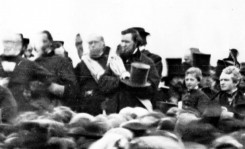Common Core, the Gettysburg Address & human intent
(H/t to Civil War Daily Gazette)
History will always be a blurry image, whether in real time today, or our understanding of it in the past. The picture above of President Lincoln at the platform in Gettysburg strikes me as powerful for all that I know and what I can only imagine of the scene and the moment in time.
The battle of ideas over how we educate our young is moving fast. The nationwide controversy about Common Core and what it means for kids in the classroom is now garnering hundreds of news articles (mainly negative) every week. That is the result of mounting pressure from parents, teachers, and legislative staff regarding the the quality of the content and the costs to states and localities. In a society where a free press constitutes a bulwark of our political and cultural system, history and public discourse are tethered to human agency and purpose in a way that is truly unique.
The sheer number of debates at the local and state level are astounding — and, frankly, hard to keep sight of.
Two stories that stand out for me this week are one in Indiana that underscores just how quickly Common Core has become as a political issue as significant as the passage and implementation of the Affordable Care Act; and, second, a controversy around Common Core’s way of teaching high school freshmen and sophomore to read the Gettysburg Address.
First out, Indiana, where the Hoosier State’s House Speaker Brian Bosma noted,
This phrase ‘Common Core’ has now become such a distraction. It is the only thing that approaches the phrase ‘Obamacare’ with concern and violent reaction around the state.
The Times of Northwest Indiana reports that Speaker Bosma, once a strong supporter of the Core, and Senate President David Long, are
direct[ing] the Republican-controlled Legislature to require Indiana create its own college- and career-ready standards, separate from Common Core.
If this is happening in Indiana, one of the states most committed to the Core, then you can understand why there are over dozens and dozens of bills around the country pausing or pulling out of the tests and/or Common Core completely.
Second up is a story this week in the Washington Post (building on previous stories on this in the Hechinger Report and elsewhere) showing how Common Core dumbs down the way in which kids read important historical texts like the Gettysburg Address. (Diane Ravitch also had a powerful blog post in response to the story.) The Post picked up on a Common Core “exemplar for instruction” created by the architects of the Core (Student Achievement Partners), which directs teachers of 9th and 10th graders to have students seek the meaning of the Gettysburg Address without reference to or knowledge of the Address’s historical context.
I was on Fox & Friends this weekend talking about the Core‘s oddly reductionist view of the role of human purpose in understanding historical texts like the Gettysburg Address to provide comment on why Common Core’s architects would develop a 30-page instructional guide telling teachers to refrain from giving any historical context.
Why no reference to that thing called the Civil War, the Battle of Gettysburg or even why President Lincoln at that moment may have traveled almost 100 miles to make the speech?
Well, as it turns out the lesson plan is actually very instructive. It was developed by SAP, a firm which was founded by David Coleman, Sue Pimentel and Jason Zimba, individuals who drove much of the Core’s development. As such, their lesson plan reveals a lot about the reading theory undergirding the Core. The lesson plan notes that teachers must emphasize “close reading,” so that kids who have historical knowledge of those events don’t have an “unfair” advantage over kids with no historical knowledge.
Think about that. The Core was marketed to states as part of a race to the top, not a race to the bottom, where — in order to ensure fairness for all students — complex historical texts must be approached at the lowest common denominator position (no historical information).
The instructional exemplar debated this week in the WaPo and elsewhere is not an anomaly: David Coleman (nice enough guy, bad ideas) restates the close-reading/
That claim has no imaginable justification. Without thinking about intention and human agency, how can students understand why Lincoln uses repetition or specific turns of phrase? Why does Lincoln push certain linguistic buttons and not others?
Set aside Common Core and common sense, of course, teaches us otherwise: History is little but the march of time without human agency and intent. Actually, it’s not even that. The clock (from the French word for bell — cloche) was created as a tool to help people organize time with purposes in mind: at first prayers, festivals, worship, and harvests; today, too much work.
Lincoln of course uses repetitions, a tone and phraseology because he has a purpose in mind. You’d have to be one of the unmarked dead on the fields of Gettysburg, to ignore human purpose in literature and such great speeches.
Coleman, contrary to the title of his October essay, is not cultivating wonder. While “why” is not the only form of wonder, it is the most persistent in a child’s mind. Any parent who’s had to plug his or her ears after the umpteenth “why” in a car ride knows that.
(Note that on Fox & Friends, I misspoke, referring to the number of casualties at Gettysburg [51,000], not the number of dead [8,000]).
Follow me on twitter at @jimstergios, visit Pioneer’s website, or check out our education posts at the Rock The Schoolhouse blog.



